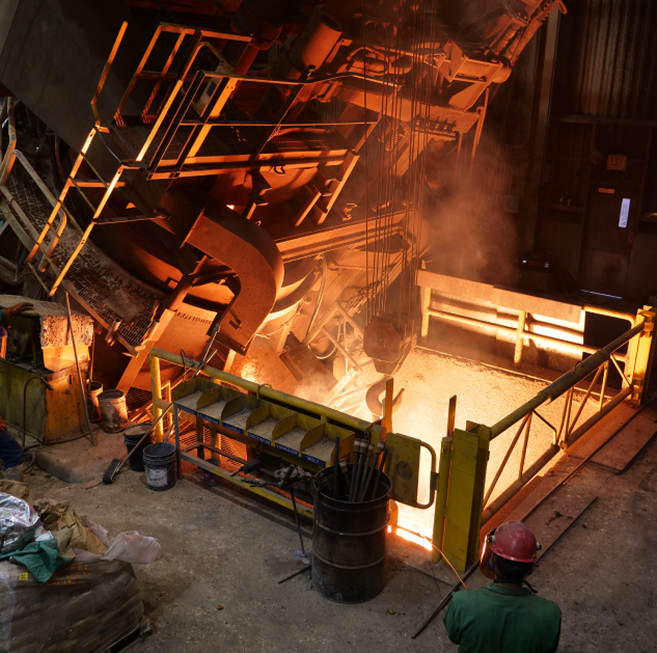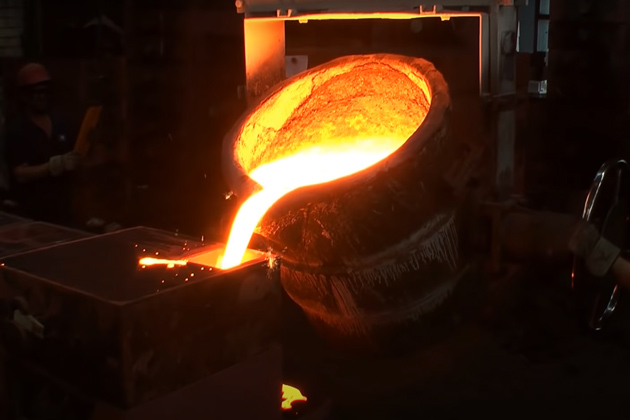Breaking down the modern advances reshaping the Aluminum Foundry industry
Wiki Article
Unveiling the Intricacies of Style and Production at a Metal Foundry
The style and production processes at a metal foundry entail a collection of complex actions. Each phase, from picking basic materials to melting and casting, plays an important function in the last item. Metal Casting. Precision and quality assurance are extremely important in this sector. As innovation developments, brand-new developments are emerging. These developments might redefine typical practices. What implications do these modifications hold for the future of metal foundries?The Melting Process: Transforming Raw Products Into Fluid Metal
The melting process works as the crucial initial step in changing resources into fluid metal, a procedure essential for foundry procedures. This phase starts with the cautious option of steels, which may include aluminum, iron, or copper, depending on the preferred final product. Each product is examined for pureness and structure to guarantee excellent melting problems.
As the steels reach their melting point, they transform from solid to fluid, enabling for further refinement. This process can additionally include the removal of contaminations through slag formation, ensuring the high quality of the fluid metal. Ultimately, the effective conclusion of the melting process lays the foundation for subsequent metalworking procedures.
Molding Methods: Shaping Metal With Accuracy
Following the melting procedure, the next stage in steel foundry operations entails molding methods that form the fluid steel right into wanted forms. Numerous methods are employed, each selected based upon the certain needs of the task. Sand spreading, one of the most usual methods, makes use of a mix of sand and binder to develop molds that can be easily formed and reused. One more technique, financial investment casting, includes developing a wax pattern that is coated in a ceramic covering, permitting for elaborate designs and high precision.Pass away spreading, on the other hand, uses high-pressure to inject molten steel into steel molds, resulting in consistent and long lasting products. Additionally, the option of molding technique impacts the cooling price, surface coating, and dimensional accuracy of the end product. Comprehending these techniques is vital for optimizing style and guaranteeing the successful production of steel components customized to details applications.
Casting Techniques: From Prototype to Production
Various spreading approaches are employed in steel foundries to move from prototype development to full-blown production. Among these approaches, sand casting stands apart for its adaptability and cost-effectiveness, making it excellent for both little and large production runs. Financial investment spreading, recognized for its accuracy, is frequently utilized for intricate geometries, enabling for fine information in the end product. Die casting, suitable for high-volume manufacturing, utilizes molten metal injected into molds, supplying exceptional surface area coating and dimensional accuracy.
Quality Assurance: Ensuring Quality in Every Pour
While the spreading process can vary greatly in between techniques, keeping strenuous top quality control is necessary to determine that every pour Aluminum Foundry satisfies the needed requirements. Quality assurance in a metal foundry includes a collection of systematic checks and evaluations created to determine problems early in the production procedure. This includes precise assessments of resources, surveillance of melting temperature levels, and evaluations of mold stability.Foundry employees use different screening methods, such as non-destructive screening and dimensional verification, to establish that castings accomplish wanted requirements. In addition, adherence to developed sector criteria and certifications boosts the integrity of the end product.
Comments loops are also critical; any kind of discrepancies noted throughout top quality analyses are evaluated to improve processes and alleviate future mistakes. Eventually, a culture of quality control cultivates not only customer satisfaction but also a track record for quality in the affordable landscape of steel manufacturing.
Advancements and Technologies: The Future of Metal Foundries
The landscape of steel shops is quickly evolving, driven by developments in innovation and innovative practices. Automation and robotics are changing traditional workflows, boosting efficiency and precision during production. Automated putting systems and robotic arms reduce human error, leading to better results. Additionally, the combination of fabricated knowledge is making it possible for anticipating maintenance, enhancing devices efficiency, and lessening downtime.Additive production is emerging as a game-changer, enabling quick prototyping and the creation of complicated geometries that were previously unattainable. This technology facilitates the modification of steel parts, providing to particular client demands without considerable time hold-ups.
Sustainability is also a key emphasis, with shops adopting greener practices, such as reusing scrap metal and using energy-efficient heaters. These developments not just boost performance yet also line up with worldwide efforts towards environmentally accountable production, ensuring the future of steel shops remains competitive and robust in an altering commercial landscape.
Often Asked Questions
What Kinds of Metals Are Generally Utilized in Shops?
Usual metals made use of in factories consist of aluminum, cast iron, bronze, brass, and steel (Aluminum Foundry). Each steel has one-of-a-kind residential or commercial properties, making them appropriate for different applications in markets such as auto, aerospace, and construction, to name a fewExactly How Do Factories Manage Waste and Environmental Impact?
Factories handle waste and environmental impact by implementing reusing programs, utilizing innovative filtration systems, and sticking to stringent regulative requirements. They often buy sustainable technologies to lower emissions and promote accountable resource use throughout their procedures.What Precaution Are in Area for Employees?
Foundries carry out various safety and security steps for workers, consisting of personal protective devices, correct ventilation systems, routine safety training, emergency situation feedback methods, and stringent adherence to work-related health policies to decrease threats related to harmful products and devices.How Lengthy Does the Entire Manufacturing Process Usually Take?
The whole manufacturing procedure typically takes a number of weeks, depending upon the intricacy of the layout and the materials used. Aspects such as mold prep work, melting, and cooling time greatly affect the general period of manufacturing.What Are the Main Tests Faced by Metal Shops Today?
Metal foundries today face difficulties such as increasing product costs, rising and fall demand, environmental guidelines, proficient labor shortages, and preserving top quality control. These problems complicate manufacturing performance and productivity in an increasingly open market.The design and manufacturing procedures at a metal foundry entail a collection of complex actions. The melting process serves as the critical very first action in changing raw materials right into fluid steel, a treatment important for foundry operations. Adhering to the melting procedure, the next stage in metal foundry operations entails molding strategies that form the liquid steel right into desired kinds. Numerous spreading approaches are employed in metal factories to move from prototype growth to full-blown manufacturing. Quality control in a metal foundry incorporates a series of systematic checks and evaluations designed to determine defects early in the production process.
Report this wiki page